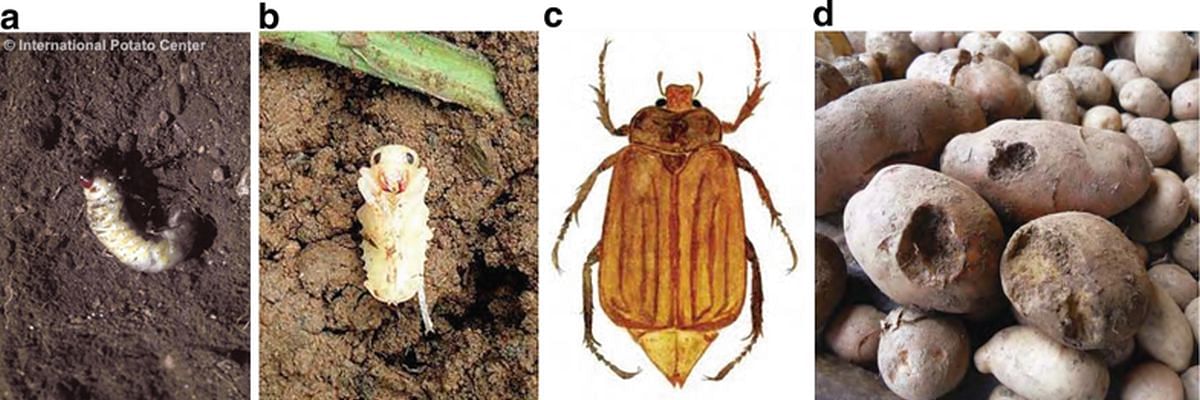Scientific description of the White Grubs(2020)
Based on J. Kroschel. et al. (2020) Insect Pests Affecting Potatoes in Tropical, Subtropical, and Temperate Regions. In: Campos H., Ortiz O. (eds) The Potato Crop. Springer, Cham
The authors of this content are Jürgen Kroschel, Norma Mujica, Joshua Okonya, Andrei Alyokhin
Phyllophaga spp ., Anomala spp ., Popillia japonica Newman , Anomala orientalis Waterhouse, Holotrichia javana Brenske , Holotrichia oblita Faldermann , Temnorhynchus coronatus (Fabricius), Holotrichia longipennis Blanchard, Brahmina coriacea Hope, Melolontha melolontha Linnaeus
(Coleoptera: Scarabaeidae)
White grubs are found in many genera in the family Scarabaeidae.
Distribution
Scarab beetles and thus white grubs are found worldwide.
Host range
White grubs are polyphagus and feed on over 1000 plant species including field crops such as potato, sweetpotato, maize, asparagus, and soybean; fruits such as apple, peach, grape, as well as trees and ornamentals (Pathania and Chandel 2016; Visser and Stals 2012; Misra and Chandel 2003) (image below).
Typical white grub larva (a) and pupa (b) of the genus Phyllophaga. Adult of Melolantha melolantha (c) and damage of larvae in potato tubers (d). (Courtesy: CIP)
Symptoms of infestation
White grubs are the larvae of relatively large beetles. The damage is done mainly by the grubs which remain in the soil. They damage the plant by feeding on roots, underground stem parts, stolons, and tubers. Earlier instars feed on the roots and may cause the plants to dry up.
After tubers are developed, the grubs switch to feeding on them, leaving large holes (BioNET-EAFRINET 2011; CIP 1996; Sanchez and Vergara 2002; Visser 2012).
Impacts on production losses
Economic damage results mostly from larval damage to potato tubers. Severe damage usually occurs when planting potato in former pasture or grazing fields, which are preferred habitats for white grubs, and on no-till or reduced-till land (CIP 1996; Larrain et al. 2003; Sanchez and Vergara 2002).
Yield losses of 40–80% have been reported in India (Pathania and Chandel 2016; Misra 1995).
Methods of prevention and control
- Cultural practices.
Deep tilling exposes white grubs to adverse environmental conditions such as sunlight and frost, and to predatory vertebrates. Ensuring proper drainage in the field will reduce white grub populations since they prefer moist soil, especially with high content of decaying organic matter. Potato should not be planted directly following pasture, grass, or several successive years of cereals and/or corn.
Crop rotation is an effective control method when potato is rotated with resistant or less susceptible crops, such as deep-rooted legumes (e.g., alfalfa, cowpea, and pigeon peas) and Allium crops (onions, garlic). Strips of African marigold (Tagetes sp.), sunflower (Helianthus annuus L.), and castor can be used as trap crops. Allium crops also repel adult beetles from laying eggs (Larrain et al. 2003; BioNET-EAFRINET 2011). - Biological control.
Natural enemies that control white grubs include parasitic wasps in the genera Tiphia, Myzinum (Hymenoptera: Tiphiidae), and Pelecinus polyturator Drury (Hymenoptera: Pelecinidae), and the fly, Pyrgota undata Wiedemann (Diptera: Pyrgotidae).
Spores of the pathogens Bacillus popilliae, B. lentimorbus, and Metarhizium anisopliae can be used to inoculate the soil. Nematodes species such as Steinernema sp. and Heterrorhabditis sp. can also be effectively used against white grubs (Sanchez and Vergara 2002). - Chemical control.
This pest is not easily controlled with insecticides. Chemical treatment on grubs must be done when they are young, as older larvae are more robust and move to a greater depth as they develop (Gupta and Gavkare 2014).

